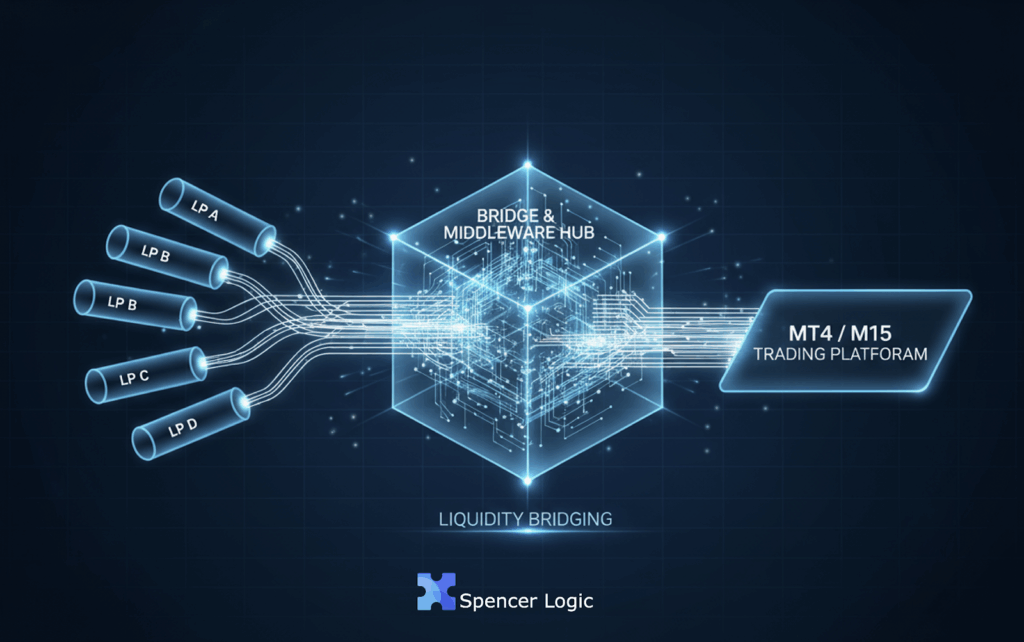
By Logic Pulse | Spencer Logic Insights Series
Every FX broker faces a similar challenge: how to provide the best possible trading experience for clients in a fiercely competitive market. For years, the conversation has been dominated by technical jargon—fill rates, slippage, and complex architecture diagrams. But what if we told you the real story of liquidity aggregation isn’t about numbers and charts? It’s about people, their problems, and the solutions that truly transform their business.
At Spencer Logic, we’ve been helping retail brokers navigate this complex landscape for years. We believe the most powerful insights come from shared experiences, not a list of features. Let us tell you a story about a broker we’ll call “Broker A.”

TL;DR
- Move beyond metrics: The real value of liquidity aggregation isn’t just about KPIs like fill rates; it’s about solving real-world problems like client complaints and lost business.
- Embrace reliability: Aggregation acts as a safety net, protecting your business from the single point of failure that comes with a single liquidity provider.
- Foster client trust: A more reliable system with fewer rejections leads to happier clients and stronger referral flows from Introducing Brokers.
- Fast, focused integration: Our solutions can be integrated in days, not months, allowing you to quickly improve execution quality without extensive delays.
- It’s about the story, not the specs: Ultimately, clients and partners want to know that your system is reliable and transparent, not get bogged down in technical details.
The Story of Broker A: A Search for Reliability
Broker A was a successful retail FX broker with a loyal client base. Their operation was solid, but they had a nagging issue: client complaints about order rejections and slow execution, especially during major news events. Their single-LP setup, while simple, left them vulnerable. When that one liquidity provider had an outage or started rejecting more orders, Broker A’s entire business was exposed.
They came to us frustrated. “My best clients are complaining, and I’m losing a few of our high-volume traders every month,” their COO told us. “I’m tired of saying, ‘It’s just market volatility.’ I need a solution.”
This wasn’t a technical problem for them; it was a trust problem. They needed to know their trading platform would be reliable, even when the market was chaotic. Their clients didn’t care about the difference between a Tier-1 bank and a non-bank LP; they cared about whether their trades were executed fairly and quickly.
We worked with them to integrate our liquidity aggregation solution, which pulls from multiple liquidity venues. Our goal wasn’t just to connect their system; it was to build a safety net. This is where the magic of a smart order router comes in. When one venue showed signs of slowing down or became unreliable, our system automatically routed their orders to another venue without missing a beat. This capability is about more than just technology—it’s about adding resilience to your business.
The result? Within a few days of a phased go-live, Broker A’s COO noticed a dramatic reduction in client complaints. Their clients felt the difference: trades that once might have been rejected were now being filled. This improved reliability led to happier clients and a stronger referral flow from their introducing brokers (IBs).
Beyond the Metrics: What Truly Matters
The initial article you read may have mentioned KPIs like Fill Rate and Slippage. While these are valuable for us to monitor behind the scenes, we don’t want our clients to get bogged down in them. Our job is to handle the complexity so you can focus on your clients.
Instead of providing you with a raw data dump, we focus on what really matters: clear, actionable insights. We believe that transparency should be in plain English, not a spreadsheet of technical terms. We give you the confidence to tell your clients: “We’re using a multi-venue system to ensure you get the best execution possible, and we have a built-in safety net.”
In the case of Broker A, the key takeaway wasn’t that their fill rate increased from 95% to 98%. It was that they could finally sleep at night knowing their business was protected from single points of failure.
A Fast-Track to Success
You might be thinking that a project like this takes months. The first article mentioned integration “in days”, and we’ve actually found that to be true, and often even faster for simple setups. We can typically get a broker started with a focused symbol pack in just 1-2 business days, running in a “shadow mode” to ensure everything works perfectly before a full rollout.
This isn’t just a promise; it’s our standard practice, designed to get you up and running quickly so you can start seeing a positive impact on your business.
We look forward to sharing more stories of how Spencer Logic has helped brokers build a more reliable and successful business.







